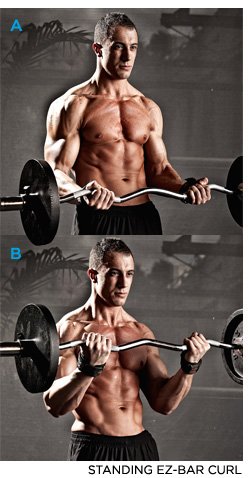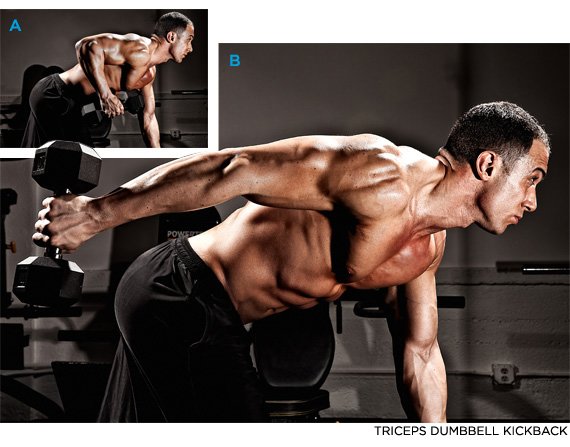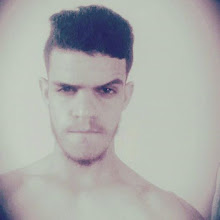Every guy wants bigger arms. It's all part of our DNA. Yet so many guys send up an SOS when it comes to forging eye-catching guns. Either they have no clue what they're doing, or they know what they should be doing, but don't want to put in the hard work.
If you're looking to add some girth to your arms by the time spring rolls around, you're not going to be able to wait until the last two weeks of March. I don't care what anybody tells you, you need to get focused now.
In order to garner gorilla arms, you need to understand the functional anatomy of the upper arms and how you can exploit it for growth.
TRI'D & TRUE
The triceps brachii are the muscles on the back of your upper arm - hopefully this comes as no surprise to you. The 'triceps' refers to the three individual heads to this muscle group: the medial head, the lateral head and the long head.

The medial and lateral heads originate in the posterior side of the humerus and attach on the olecranon process of the ulna.
The long head is unique in that it originates on the scapula, then converges with the medial and lateral heads to attach at the olecranon process. This is a key piece of information for any arm specialization program; it tells us that, by flexing the shoulder (lifting it overhead), we increase the stretch and recruitment of the long head.
The triceps brachii work together to promote elbow extension. The long head is also a weak shoulder extensor/adductor, because it attaches to the scapula.
While it's not a major player like the triceps, the anconeus is frequently lumped in with the triceps; it also factors in elbow extension.
BI'S BY THE BOOK
The biceps brachii are the muscles on the front of your upper arm. Like you didn't already know that … right? The word biceps refers to two intersecting muscle heads: the short head and the long head.

The short head of the biceps originates on the coracoid process of the scapula. The long head originates on the supraglenoid tubercle. The long and short heads intersect to insert on the radial tuberosity.
If you want to focus on the long head of your biceps, extend the shoulder or get your elbow slightly behind your body. This is most-easily done using incline curl variants.
In contrast, moving the elbow in front of the body (a la preacher curl variants) is going to put more stress on the short head of the biceps.
Another strong elbow flexor is the brachialis. You activate the brachialis by positioning your forearm in a pronated (hand is facing down) position.
When your forearm is pronated, the attachment of the biceps is somewhat blocked by the radius. This makes for an inefficient line of pull, and explains why you are weaker in reverse-grip curl variations.
Neutral or supinated (palms facing up) grips improve your line of pull because they recruit the biceps instead of the brachialis.
TRICEPS TIPS
FOR BIG TRICEPS, LEARN
FROM POWERLIFTERS :
Regardless of how you may feel about powerlifting, there's no doubt that many of these guys and gals sport some seriously large triceps. And yet, rarely (if ever) do powerlifters incorporate isolative triceps training into their programming.
Instead, the bulk of a powerlifter's program is geared around building a bigger squat, bench press and deadlift. For triceps, the key lift here is the bench press.
Bench variant bicep-building exercises include traditional bench press and close-grip variations, as well as exercises focused on building the lockout, such as floor presses and board presses. All of these ignite triceps. Throw in some heavy extension work, like skullcrushers on a flat or decline bench, and you have the blueprint to turn those pipe cleaners into pipes!

GO OVERHEAD TO HIT THE
LONG HEAD :
Big, compound exercises are critical to developing mass, but if you want maximum recruitment and development of the long head, you need to incorporate overhead triceps work.
By flexing the shoulder, you effectively put the long head of the triceps on stretch. My favorite exercises for long head activation are overhead extensions using a dumbbell or rope attachment.
BICEPS BONUS :

FOR BIGGER
BICEPS, LEARN
FROM
BODYBUILDERS :
While powerlifters have the big triceps, they spend little to no time on their biceps.
If you want to learn more about building bigger biceps, examine the training of elite bodybuilders - they have one specific trick:
They realize that by manipulating the position of their shoulder and/or wrist, they can preferentially recruit different muscles!
In other words, any exercise where your elbow is behind the midline of the body is puts a heavy emphasis on the long head of the biceps. Any exercise where the elbow is in front of the midline of the body puts greater emphasis on the short head of the biceps.
And finally, any exercise with pronated forearms positions the biceps for poor mechanical advantage, and thus stresses your brachialis muscle.
For proportional and well-developed bis, you need to hit each muscle. Incorporate exercises with varying degrees of shoulder flexion and forearm positioning.
MORE TO KNOW
START BIG, FINISH SMALL :
If you want huge friggin' arms, there is no way around it; you must push the envelope with your training. That means for triceps, the bulk of your workouts should start with a big exercise like close-grip bench presses, dips or possibly board presses.
For biceps, the same thing should happen: start with an exercise where you can move the most weight, such as anEZ-curl bar or straight barbell curl, then move to auxiliary exercises afterward.
I don't care how hard you work at your triceps kickbacks, they simply cannot substitute the big-bang exercises.

BICEPS/TRICEPS SUPERSETS
MAY NOT BE SO SUPER :
I know a lot of coaches who espouse supersets for arm training. This means doing a set for biceps and then immediately doing a set for triceps. This method can no doubt lead to an awesome street pump, but there is an underlying issue I'm not sure most people understand.
A concept known as reciprocal inhibition tells us that if an agonist muscle is turned on, then the antagonist will shut off. We see this all the time in the case of hip flexors - they become short and stiff which, to some extent, shuts off the glutes.

With regard to arm training, if we do a set of triceps that effectively decreases nervous system recruitment to our biceps, we do a disservice to our growth.
Alternating between biceps and triceps is akin to driving a car forward, then backing up over and over. It doesn't make sense. The better strategy is to train one specific muscle group with wild abandon, then switch gears and go all-out on the other.
Keep In Mind: you don't necessarily have to train both biceps and triceps on the same day. But if you do, do all triceps exercises before you start biceps.
Even though I'm a powerlifter, I still say: of all the things we do in the gym, arm training is possibly the most fun.
If you want to maximize your arm development, you need to take some of this newfound knowledge and couple it with hard work in the gym. If you do, chances are you'll be sporting a serious set of guns before summer rolls around.
Now get the hell off the computer, get to the gym and do some work!
THE PROGRAM :
I hate giving cookie-cutter programs, so I will do my best to give you a program you can customize and tweak to your own liking. Sort of like those Choose Your Own Adventure books, you'll be able to follow the basic principles I outlined above, but still have the freedom to utilize your favorite exercises.
Lead the charge with a "main" exercise (and a Braveheart yell), and then hit your ancillary stuff from there. You wouldn't start a meal without quality protein; there's no sense starting your arm training with sissy, toned-down exercises!



0 Comment to "The Science Of Arm Training"
Enregistrer un commentaire